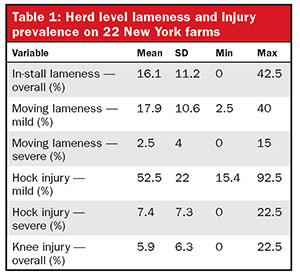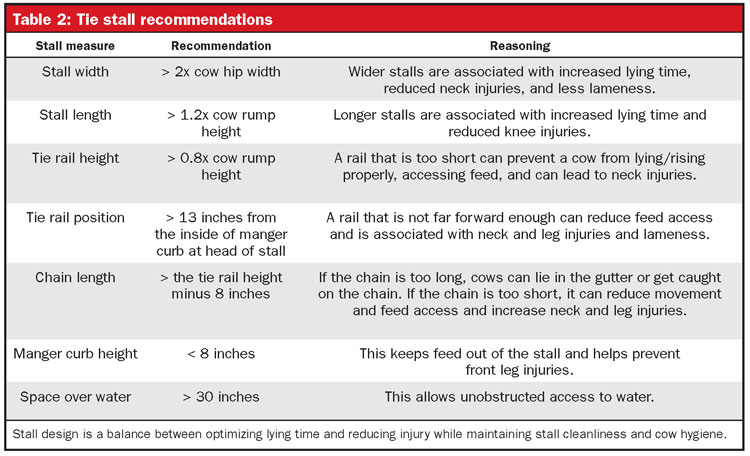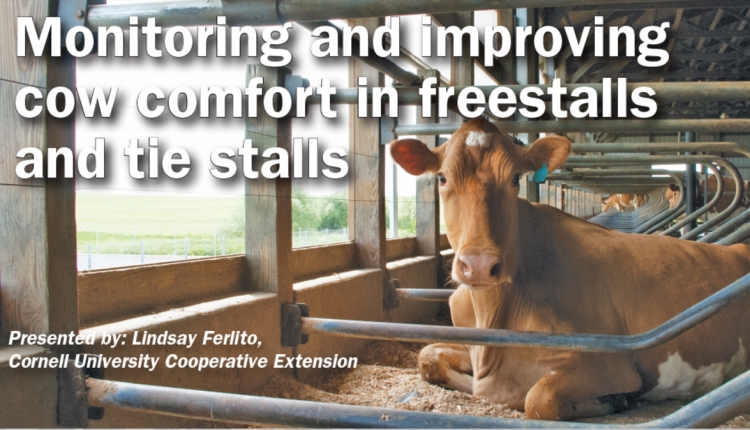Often, producers will recognize an issue but are hesitant to make changes for a myriad of reasons. They may not know what changes to make, or they may want to avoid the cost of retrofits or capital improvements. Or, perhaps they lack confidence in the changes recommended.
Lameness remains one of the most costly issues for dairies due to lost milk production, compromised reproduction, a higher risk of culling, and greater treatment and labor costs. New estimates for lameness are over $400 per case, with only 5 to 6 percent of the cost being related to treatment. Additionally, with greater consumer interest in animal care and on-farm welfare evaluations, the cost of lameness is more than just a dollar amount.
A focus on tie stalls
Recent research on lameness and cow comfort has focused on freestall barns. Meanwhile, little emphasis has been placed on tie stall facilities, even though they are still very common, especially in states like New York.
Further, with the implementation of the National FARM (Farmers Assuring Responsible Management) Program, almost all producers have experienced an on-farm evaluation and will need to meet industry targets for cow comfort. Therefore, the goals of our project were to create a cow comfort benchmark specifically for tie stall herds, while providing individuals with farm-specific feedback so they can make informed decisions to improve cow comfort on their dairies.
Through funding provided by the New York Farm Viability Institute, 22 farms participated in the study, with data collected from the spring of 2017 to the summer of 2018. Each farm was assessed for lying behavior, lameness, and injuries, plus facility and management factors including stall dimensions and bedding. After completing the first assessment, each farm received a report showing their farm-specific data and how they compared to the study benchmark.
Some targets were missed

When considering the National FARM Program, these herds met the target for severe lameness prevalence, which was less than 5 percent. Under the National FARM Program, a score of 3 indicates severe lameness. This is an animal that is unable to move or that is barely able to put weight on the affected limb.
The group did not meet the target for severe hock and knee injuries to be less than 5 percent, though. Severe hock or knee injuries are given a score of 3, which means there is visible swelling and/or an abrasion through the hide.
The recommendations listed in Table 2 are from the Ontario Ministry of Agriculture, Food and Rural Affairs. These numbers are based on cow size and follow research guidelines we took into consideration.
No farm met every single recommendation for stall size. Eight of the 22 farms met (or were very close to meeting) the recommendations for stall length, and 15 farms met specifications for stall width. None of the farms met the recommendation for both tie rail height and position, and only four herds met one of the recommendations for either tie rail height or position.

Small changes can be made
Producers found value in having an on-farm evaluation and seeing their results and the comparison to the benchmark of their peers. For example, one herd had already retrofitted part of their barn before the study. They were anxious to see how the changes had improved cow comfort and if it was worth the effort to retrofit the rest of the barn.
The data from their evaluation showed they had very low lameness prevalence. Their cows were spending a good amount of time lying down in their stalls even when they were provided with access to pasture for part of the day, indicating they were comfortable in the stalls. This proved to the farmer that the retrofits were worth the investment and that they should continue making improvements throughout the rest of the barn.
Another farmer even showed his report to his financial lender to highlight the work he was doing to maintain an above average level of cow comfort on his dairy.
With low milk prices, many producers have stated they are currently unable to make large capital investments on their farm. However, changes don’t have to be large or costly to have a positive impact.
One of the improvements that participating farms made included learning how to do lameness scoring so they could identify lame cows earlier, which reduced the severity and prevalence of lameness on the farm and the costs associated with it.
Another farm recognized they couldn’t afford new mattresses. Instead, they started to use more bedding to provide cows with a more comfortable place to lay down and hopefully reduce injuries and lameness.
Some producers have been able to make incremental changes to their facilities, including redesigning stalls to the appropriate dimensions to fit their cows and lengthening the tie rail chain to provide cows more freedom of movement and to help reduce injuries. Other producers have been able to replace stall mattresses or purchase additional fans and sprinklers to reduce heat stress in the summer and promote lying time.
This study offered an opportunity to provide solid data to producers as well as the dairy industry on factors important to cow comfort in tie stall facilities. By benchmarking herds that manage their cows in tie stalls, we can provide a dataset that shows tie stall herds achieve animal welfare standards.
In today’s world, producers are constantly under scrutiny and are receiving pressure from the public and industry alike. Studies like this can give producers in these facilities tools to improve their situation by elevating cow comfort and profitability at the same time.









